PR
X
Keyword Search
▼キーワード検索
Comments
続日本100名城東北の…
New!
オジン0523さん
【甥のステント挿入… New!
Gママさん
New!
Gママさん
2025年版・岡山大学… New!
隠居人はせじぃさん
New!
隠居人はせじぃさん
ムベの実を開くコツ… noahnoahnoahさん
noahnoahnoahさん
エコハウスにようこそ ecologicianさん
【甥のステント挿入…
 New!
Gママさん
New!
Gママさん2025年版・岡山大学…
 New!
隠居人はせじぃさん
New!
隠居人はせじぃさんムベの実を開くコツ…
 noahnoahnoahさん
noahnoahnoahさんエコハウスにようこそ ecologicianさん
Calendar
カテゴリ: 海外旅行
この日は6月4日(水)、まずは「 Ross Castle
(ロス城)」に向かったのであった。
宿泊場所の APARTMENTSの内部の居間の写真を撮影。
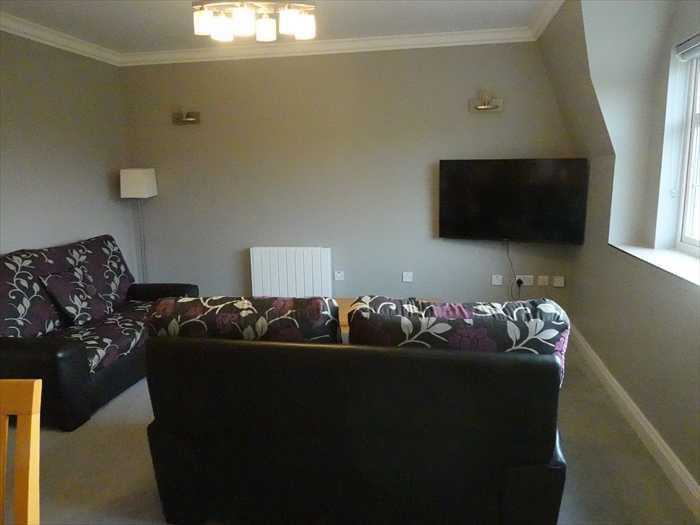
台所。

台所横のテーブル。

キッチンルームの全体を。

テレビのニュースでは、 日本野球界のレジェンド・長嶋茂雄氏が89歳で逝去 されたと。

大谷翔平の活躍のニュース も。

Ross Castle 」への走行ルート。
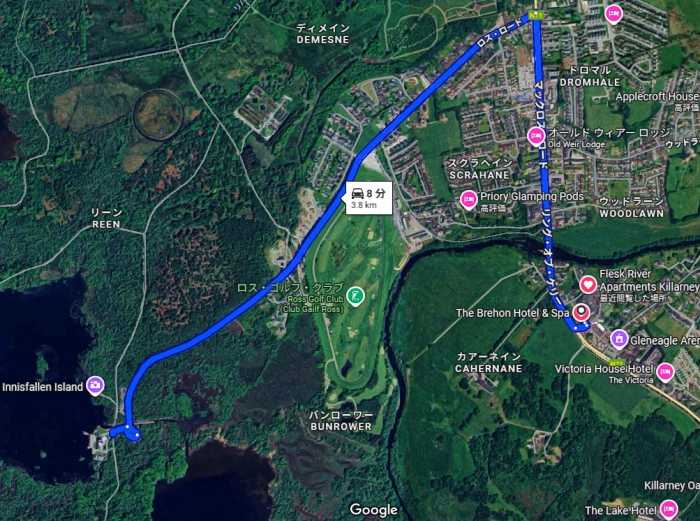
「 Lough Leane・レイン湖 」に面した「 Ross Castle・ロス城 」はここ。
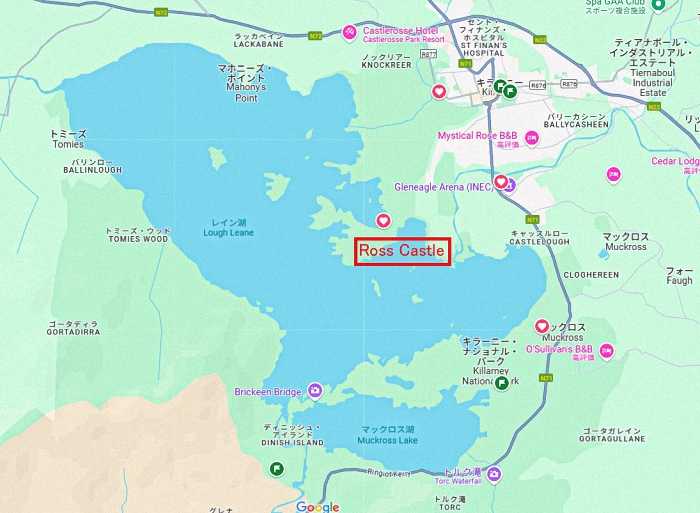
Ross Castle(ロス城)近くにある「 Garden Café(ガーデン・カフェ) 」への案内看板。

そして正面に「 Ross Castle・ロス城 」👈️リンク の姿が現れた。
湖面に映る城のリフレクション が非常に美しく、晴れでも曇りでも絵になる風景なのであった。
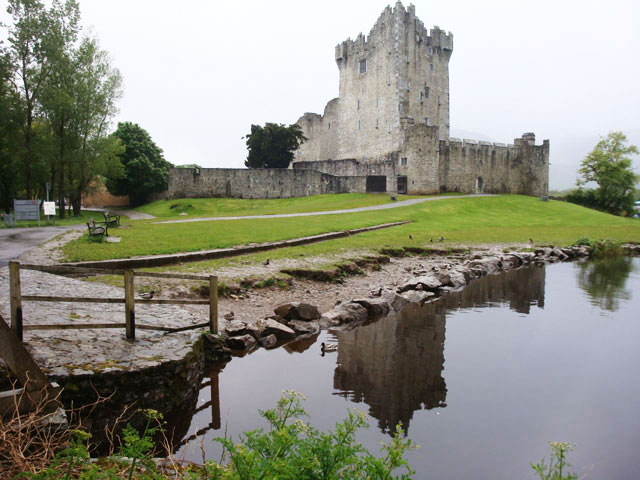
Ross Castle・ロス城
宿泊場所の APARTMENTSの内部の居間の写真を撮影。

台所。

台所横のテーブル。

キッチンルームの全体を。

テレビのニュースでは、 日本野球界のレジェンド・長嶋茂雄氏が89歳で逝去 されたと。

大谷翔平の活躍のニュース も。

Ross Castle 」への走行ルート。

「 Lough Leane・レイン湖 」に面した「 Ross Castle・ロス城 」はここ。

Ross Castle(ロス城)近くにある「 Garden Café(ガーデン・カフェ) 」への案内看板。

そして正面に「 Ross Castle・ロス城 」👈️リンク の姿が現れた。
湖面に映る城のリフレクション が非常に美しく、晴れでも曇りでも絵になる風景なのであった。

Ross Castle・ロス城
・築城時期:15世紀後半
・築城者 :オドノフー家(O'Donoghue clan)
・所在地 :キラーニー国立公園(Killarney National Park)内、
ロッホ・レーン(Lough Leane)湖畔
ロッホ・レーン(Lough Leane)湖畔
・建築様式:中世の塔屋(Tower House)形式
・特徴:
・厚い石壁と狭間(はざま=矢を射るための小窓)
・湖に面した立地で、戦略的・防衛的に重要な城であった
・アイルランド伝説では、この城の主「O’Donoghue」が湖の底に住み、霧の日には馬に
乗って現れるとされます。」

「Ross Castle
乗って現れるとされます。」

「Ross Castle
Built for the O’Donoghue Chieftains during the first half of the 15th century, Ross Castle
has a typical tower house layout, with a banqueting hall and minstrel’s gallery on the top
floor.It was battlemented in the Irish fashion, and was surrounded by a bawn wall with
flanking towers at each corner, two of which now remain.」
【 ロス城
15世紀前(約1440年頃)にオドノフー族の族長たち(O’Donoghue Chieftains)によって
建てられた。
has a typical tower house layout, with a banqueting hall and minstrel’s gallery on the top
floor.It was battlemented in the Irish fashion, and was surrounded by a bawn wall with
flanking towers at each corner, two of which now remain.」
【 ロス城
15世紀前(約1440年頃)にオドノフー族の族長たち(O’Donoghue Chieftains)によって
建てられた。
この城は、以下のような典型的な塔屋式レイアウトを持っています:
・宴会場(バンケットホール)
・最上階には吟遊詩人(ミンストレル)のギャラリー
また、この城はアイルランド式の防御構造(battlemented in the Irish fashion)を採用しており、
四隅に防御用の塔(flanking towers)が設けられた防壁(bawn wall)に囲まれていました。
現在、そのうちの2つの塔が現存しています。

「 Ross Catle
Ross Catle is tower, built sometimes in the late 15th century by the O'Donoghue family
who ruled the Killarney area at the time.
【ロス城
ロス城は「塔屋式(タワーハウス)」の城で、15世紀後半ごろに当時キラーニー一帯を
支配していたオドノフー一族によって建てられました 。】
「 About 1500
The castle was originary continued inside a strong stone bawn wall。Outside this ,
there was probably an earthen bank and wooden palisade whichi enclosed an area called
the bailey.The thatched houses insaide this were the homes at O'Donoghus's retainers
or possibly of hired soldeiers.」
【1500年頃
この城は、もともと頑丈な石造りの防御壁(バウン)の内側にありました。
開館時間
(Opening Hours)
3月〜11月(March to November)
9:30 – 17:00
最終入場
:閉館の1時間前】
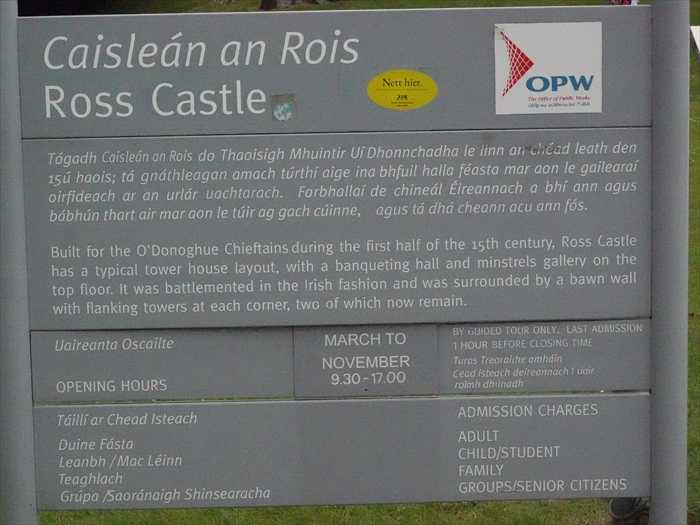
左手に「 Ross Catle 」絵入り案内板。

左手に「 Ross Catle 」絵入り案内板。

「 Ross Catle
Ross Catle is tower, built sometimes in the late 15th century by the O'Donoghue family
who ruled the Killarney area at the time.
【ロス城
ロス城は「塔屋式(タワーハウス)」の城で、15世紀後半ごろに当時キラーニー一帯を
支配していたオドノフー一族によって建てられました 。】
「 About 1500
The castle was originary continued inside a strong stone bawn wall。Outside this ,
there was probably an earthen bank and wooden palisade whichi enclosed an area called
the bailey.The thatched houses insaide this were the homes at O'Donoghus's retainers
or possibly of hired soldeiers.」
【1500年頃
この城は、もともと頑丈な石造りの防御壁(バウン)の内側にありました。
その外側には、おそらく土塁と木製の柵(パリセード)が築かれ、「バウン」と呼ばれる区域を
囲っていたと考えられます。
その内部には藁葺き屋根の家々があり、これらはオドノヒュー家に仕える家臣たち、あるいは
雇われた兵士たちの住居であった可能性があります。】
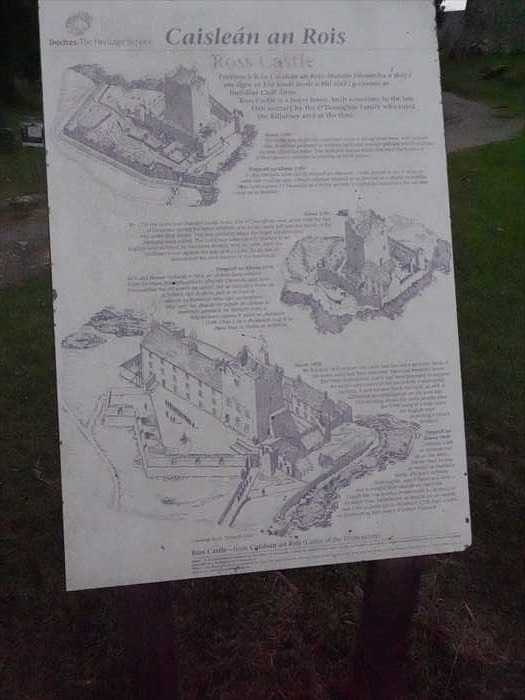
ロス城(Ross Castle)の建設当初(約1500年頃)の復元図.
この時代のロス城は、オドノヒュー家(O'Donoghue family)によって建てられたもので、
アイルランドの伝統的な塔型住宅(Tower House)として、防御機能を重視した構造に
なっている と。
① タワーハウス(中央の高い塔)
・ 居住と防御を兼ねた主建造物。通常4〜5階建てで、最上部には防御用の胸壁(パラペット)。
・ 小さな窓と厚い石壁により、攻撃への防備が強化されています。
② バウン・ウォール(城壁)
・主塔の周囲を囲む堅牢な石壁。四隅に**小塔(タレット)**があり、見張りと防衛に使用。
・外敵の侵入を防ぐため、壁内は一つの閉じた防衛区域になっています。
③ 内部の茅葺き家屋群(内部の建物)
・城主の家臣や使用人の住居、倉庫、厨房など。
・中庭(バリー)には、木造または石造の建物が複数建ち並んでいました。
④ 外周の木製柵と堀
・石壁の外側には、おそらく木製の柵(パリセード)や堀が設けられ、さらに防衛を強化。
・図の下部(入口側)に橋が描かれており、跳ね橋や門番小屋の存在が示唆されます。
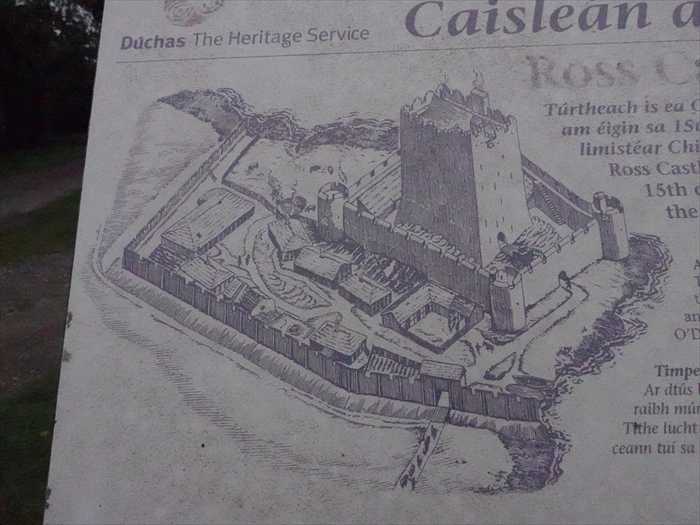
About 1700
By 1700 the castle had changed hands twice. The O'Donoghues were allied
with the Earl of Desmond during his failed rebellion and so the castle fell into
the hands of the McCarthy Mor family. This was probably when the larger windows
and bartizans were added. The castle was subsequently granted to an English land
surveyor Sir Valentine Browne who, in 1688, built the fortified house against the
side of the castle. To do this he demolished the west section of the bawn wall.
【 1700年頃
1700年までに、この城は2度にわたって所有者が変わっていた。オドノヒュー家は反乱に失敗した
デズモンド伯爵と同盟を結んでいたため、城はマッカーシー・モア家の手に渡った。おそらく
このとき、大きな窓やバーティザン(張り出し小塔)が追加されたと思われる。その後、この城は
イングランドの土地測量技師であるサー・ヴァレンタイン・ブラウンに与えられた。彼は
1688年に城の側に要塞化された邸宅を建設したが、そのために城の西側にあった城壁
(ボーン・ウォール)の一部を取り壊した。】
「ロス城(Ross Castle)」の1700年ごろの姿を再現したイラスト 。
この時代は、ロス城がオドノヒュー家(O'Donoghue)からイングランドの地図測量官
バレンタイン・ブラウン(Valentine Browne)に渡った後の状態を描いている と。
① 主塔(タワーハウス)
・中央の高くそびえる塔が、15世紀後半に建てられたオリジナルの要塞です。
・防衛に優れた構造で、上部にはマーダーホール(殺人孔)や胸壁(パラペット)が見られます。
② バウン・ウォール(外壁)
・城の敷地を囲む頑丈な石壁で、角には見張り用の小塔(タレット)が設けられています。
・攻撃に備えて外部と内部を区画し、守備力を高める設計。
③ 居住棟(長屋)
・手前の長い建物は、ブラウン卿(Sir Valentine Browne)によって1688年に建てられたもの。
・居住空間または管理施設として使用されていたと考えられます。
④ 馬や荷車のある中庭
・中庭には馬や荷車、作業用の人々が描かれており、生活や管理機能の拠点だった様子がわかります。
・城の防衛だけでなく、経済や生活の中心としての役割も果たしていたことを示しています。
⑤ 通路と堀
・図の左側には、城へ続く道や橋が見られます。堀があった可能性もあります。
歴史的背景
・オドノヒュー家は、デズモンド伯の反乱に加担して敗北し、城を失いました。
・その後、城はマッカーシー・モー家(McCarthy Mór)を経て、1688年にブラウン卿へ
譲渡されました。
・ブラウン卿は、城の西側に自らの居住棟を建設し、そのために西側のバウンウォールを
取り壊したと記録されています。

About 1800
By the mid-18th century the castle had become a garrison. Most of the bawn walls had
been removed, Valentine Browne's house had been demolished, and it had been
necessary to support the north-west corner of the castle with a substantial buttress.
A new barrack block was built, as well as additional accommodation on the west side.
This drawing shows the castle shortly after the 1798 rising at a time when the English
were expecting a French invasion.」
【 1800年頃
この図は、 ロス城(Ross Castle)の1800年頃の様子を再現したイラスト 。
囲っていたと考えられます。
その内部には藁葺き屋根の家々があり、これらはオドノヒュー家に仕える家臣たち、あるいは
雇われた兵士たちの住居であった可能性があります。】

ロス城(Ross Castle)の建設当初(約1500年頃)の復元図.
この時代のロス城は、オドノヒュー家(O'Donoghue family)によって建てられたもので、
アイルランドの伝統的な塔型住宅(Tower House)として、防御機能を重視した構造に
なっている と。
① タワーハウス(中央の高い塔)
・ 居住と防御を兼ねた主建造物。通常4〜5階建てで、最上部には防御用の胸壁(パラペット)。
・ 小さな窓と厚い石壁により、攻撃への防備が強化されています。
② バウン・ウォール(城壁)
・主塔の周囲を囲む堅牢な石壁。四隅に**小塔(タレット)**があり、見張りと防衛に使用。
・外敵の侵入を防ぐため、壁内は一つの閉じた防衛区域になっています。
③ 内部の茅葺き家屋群(内部の建物)
・城主の家臣や使用人の住居、倉庫、厨房など。
・中庭(バリー)には、木造または石造の建物が複数建ち並んでいました。
④ 外周の木製柵と堀
・石壁の外側には、おそらく木製の柵(パリセード)や堀が設けられ、さらに防衛を強化。
・図の下部(入口側)に橋が描かれており、跳ね橋や門番小屋の存在が示唆されます。

About 1700
By 1700 the castle had changed hands twice. The O'Donoghues were allied
with the Earl of Desmond during his failed rebellion and so the castle fell into
the hands of the McCarthy Mor family. This was probably when the larger windows
and bartizans were added. The castle was subsequently granted to an English land
surveyor Sir Valentine Browne who, in 1688, built the fortified house against the
side of the castle. To do this he demolished the west section of the bawn wall.
【 1700年頃
1700年までに、この城は2度にわたって所有者が変わっていた。オドノヒュー家は反乱に失敗した
デズモンド伯爵と同盟を結んでいたため、城はマッカーシー・モア家の手に渡った。おそらく
このとき、大きな窓やバーティザン(張り出し小塔)が追加されたと思われる。その後、この城は
イングランドの土地測量技師であるサー・ヴァレンタイン・ブラウンに与えられた。彼は
1688年に城の側に要塞化された邸宅を建設したが、そのために城の西側にあった城壁
(ボーン・ウォール)の一部を取り壊した。】
「ロス城(Ross Castle)」の1700年ごろの姿を再現したイラスト 。
この時代は、ロス城がオドノヒュー家(O'Donoghue)からイングランドの地図測量官
バレンタイン・ブラウン(Valentine Browne)に渡った後の状態を描いている と。
① 主塔(タワーハウス)
・中央の高くそびえる塔が、15世紀後半に建てられたオリジナルの要塞です。
・防衛に優れた構造で、上部にはマーダーホール(殺人孔)や胸壁(パラペット)が見られます。
② バウン・ウォール(外壁)
・城の敷地を囲む頑丈な石壁で、角には見張り用の小塔(タレット)が設けられています。
・攻撃に備えて外部と内部を区画し、守備力を高める設計。
③ 居住棟(長屋)
・手前の長い建物は、ブラウン卿(Sir Valentine Browne)によって1688年に建てられたもの。
・居住空間または管理施設として使用されていたと考えられます。
④ 馬や荷車のある中庭
・中庭には馬や荷車、作業用の人々が描かれており、生活や管理機能の拠点だった様子がわかります。
・城の防衛だけでなく、経済や生活の中心としての役割も果たしていたことを示しています。
⑤ 通路と堀
・図の左側には、城へ続く道や橋が見られます。堀があった可能性もあります。
歴史的背景
・オドノヒュー家は、デズモンド伯の反乱に加担して敗北し、城を失いました。
・その後、城はマッカーシー・モー家(McCarthy Mór)を経て、1688年にブラウン卿へ
譲渡されました。
・ブラウン卿は、城の西側に自らの居住棟を建設し、そのために西側のバウンウォールを
取り壊したと記録されています。

About 1800
By the mid-18th century the castle had become a garrison. Most of the bawn walls had
been removed, Valentine Browne's house had been demolished, and it had been
necessary to support the north-west corner of the castle with a substantial buttress.
A new barrack block was built, as well as additional accommodation on the west side.
This drawing shows the castle shortly after the 1798 rising at a time when the English
were expecting a French invasion.」
【 1800年頃
18世紀中頃までに、この城は駐屯地(ガリソン)として使われるようになっていた。
ボーン・ウォール(防御用の外壁)のほとんどが取り壊され、ヴァレンタイン・ブラウンが
建てた家屋も撤去されていた。その結果、城の北西角を支えるために大きな控え壁
(バットレス)を設置する必要があった。さらに、新たな兵舎棟と、西側には追加の宿泊施設が
建設された。この図は、1798年の蜂起直後、イギリス側がフランスの侵攻を予期していた時代の
城の様子を示している。】
ボーン・ウォール(防御用の外壁)のほとんどが取り壊され、ヴァレンタイン・ブラウンが
建てた家屋も撤去されていた。その結果、城の北西角を支えるために大きな控え壁
(バットレス)を設置する必要があった。さらに、新たな兵舎棟と、西側には追加の宿泊施設が
建設された。この図は、1798年の蜂起直後、イギリス側がフランスの侵攻を予期していた時代の
城の様子を示している。】
この図は、 ロス城(Ross Castle)の1800年頃の様子を再現したイラスト 。
このイラストは、1798年のアイルランド蜂起直後、フランス軍の侵攻が懸念された時期の
ロス城を描いている。18世紀後半の軍事施設(ガリソン)としての様子を示しており、
追加の兵舎や防衛施設が見られるのだ。
ロス城を描いている。18世紀後半の軍事施設(ガリソン)としての様子を示しており、
追加の兵舎や防衛施設が見られるのだ。
主な構造と説明
① ロス城の本体(中央の高い塔)
・15世紀にオドノヒュー(O'Donoghue)一族が建てた塔屋(タワーハウス)。
・石造の高い主塔(keep)で、かつての領主の居住・防衛の中心。
② 煙突のある長い建物(兵舎・バラック)
・18世紀に建てられた兵舎棟(Barrack block)。
・兵士の宿泊施設として使われていた。
・城の南側(イラストの左)に延びるように設置。
③ 外壁(バウン・ウォール:Bawn Wall)
・城を取り囲んでいた石の外壁。
・この時期にはほとんどが撤去されているが、一部が残されている。
④ 控え壁(バットレス)
・城の北西角を支えるための補強壁(buttress)。
・土台が弱くなっていた箇所を補強している。
⑤ 西側の追加施設(小屋や補助建物)
・西側には炊事場や倉庫、衛生施設などが追加されていた。
・軍の駐屯に伴う生活機能が強化されている。
⑥ 川(湖)沿いの護岸と上陸場
・城の周辺にはロッシ湖(Lough Leane)が広がっており、船着き場や護岸も描かれている。
・水路による補給や移動も考慮されていた。
図は D. Tietzsch-Tyler 氏によって描かれたもの。
下部のキャプションに「Ross Castle — from Caisleán an Rois (Castle of the Promontory)」
とあり、城の正式な意味が記されている と( Caisleán an Rois は「岬の城」 )。
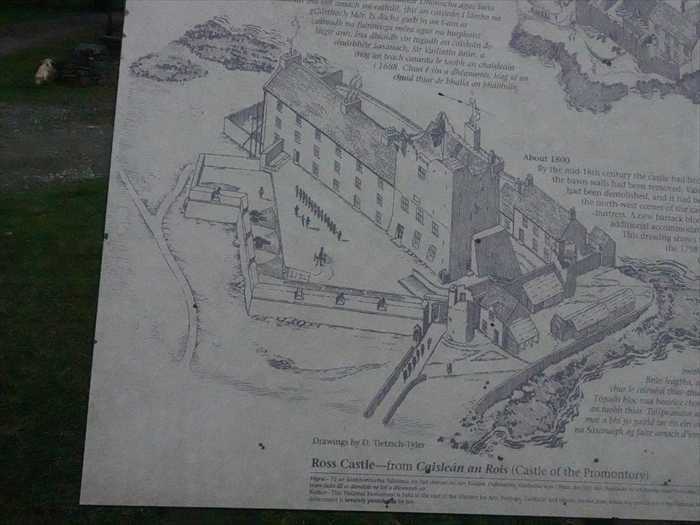
ここにも「ROSS CASTLE」案内板。
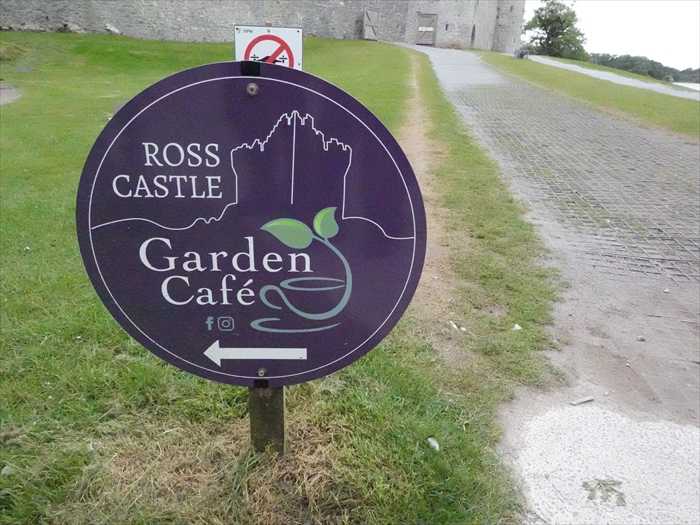
「ROSS CASTLE・ロス城」前に広がる「 Lough Leane・レイン湖 」。
レイン湖(Lough Leane, アイルランド語: Loch Léin)は、アイルランド南西部のケリー県
(County Kerry)に位置する キラーニー国立公園(Killarney National Park)の中心的な湖 。
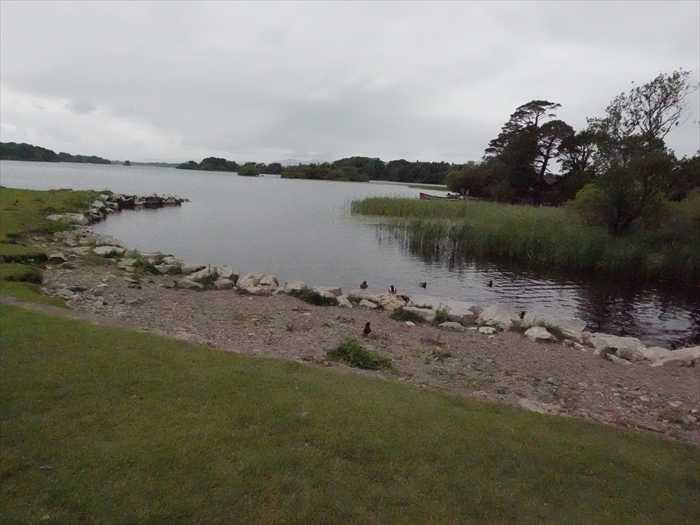
多くの野鳥が羽を休めていた。

とあり、城の正式な意味が記されている と( Caisleán an Rois は「岬の城」 )。

ここにも「ROSS CASTLE」案内板。

「ROSS CASTLE・ロス城」前に広がる「 Lough Leane・レイン湖 」。
レイン湖(Lough Leane, アイルランド語: Loch Léin)は、アイルランド南西部のケリー県
(County Kerry)に位置する キラーニー国立公園(Killarney National Park)の中心的な湖 。

多くの野鳥が羽を休めていた。

マガモ(Mallard)のオス(雄)であっただろうか?
・頭部が緑色の光沢(金属光沢のある濃緑)
・くちばしが黄色
・胸は栗色、腹は灰色、尾は白黒
・翼の中央に「青紫色の翼鏡(よくきょう)」があり、白い縁取りがある
・脚は橙色(オレンジ)
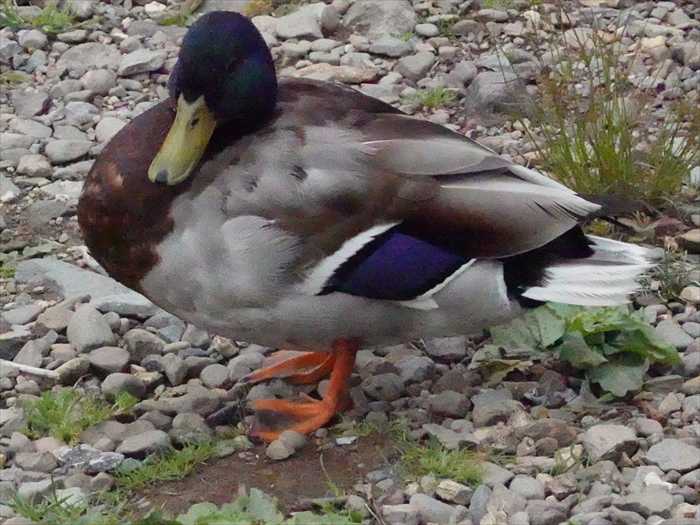
高さ約5階建ての 塔屋式天守(Tower House) を正面に。

ズームして。

高さ約5階建ての 塔屋式天守(Tower House) を正面に。

ズームして。
・四隅に見張り塔を備えた「バウン・ウォール(防御壁)」が城を取り囲んでいた。
(現在は部分的に残存)
(現在は部分的に残存)
・最上階には出窓式のミンストレルギャラリー(楽師の間)が設置されていた。
・頑丈な石造りで、敵の侵入を防ぐための狭間(arrow slits)や防御的な出入口が見られる。

再び「 Lough Leane・レイン湖 」を。
面積 約 19.6 km²(平方キロメートル)
最大長 約 8 km(南北方向)
最大幅 約 3 km(東西方向)
最大水深 約 60 m(推定)
標高 約 20 m(海抜) と。
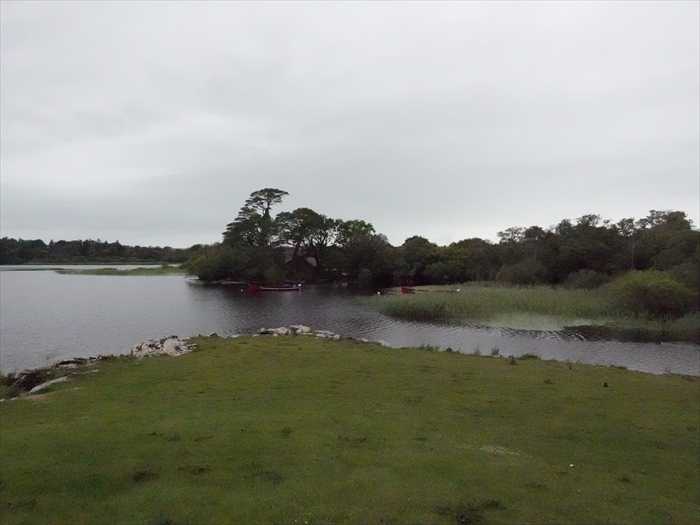
現在の関係者通用門であっただろうか?
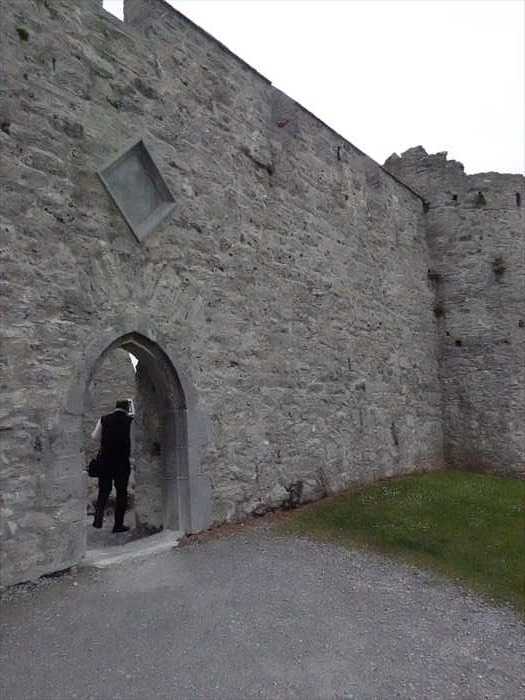
写真の門は主門(大きな正面の出入口)ではなく、側面の壁に設けられた小規模な出入口。
アーチ型の石積みで、上部には監視・防御目的の窓(または射撃口)が設けられていた。
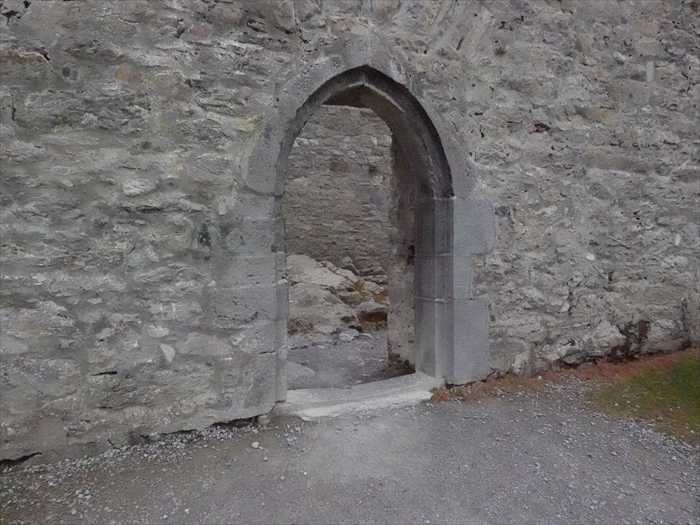
ロス城(Ross Castle)の 主塔(タワーハウス/keep) を真下から見上げて。

再び「 Lough Leane・レイン湖 」を。
面積 約 19.6 km²(平方キロメートル)
最大長 約 8 km(南北方向)
最大幅 約 3 km(東西方向)
最大水深 約 60 m(推定)
標高 約 20 m(海抜) と。

現在の関係者通用門であっただろうか?

写真の門は主門(大きな正面の出入口)ではなく、側面の壁に設けられた小規模な出入口。
アーチ型の石積みで、上部には監視・防御目的の窓(または射撃口)が設けられていた。

ロス城(Ross Castle)の 主塔(タワーハウス/keep) を真下から見上げて。
壁面に多数ある縦長の 細いスリット状の開口部は、「矢狭間」または「銃眼」
と呼ばれる。
中世の初期には弓やクロスボウ、後期には火縄銃(アーキバスなど)で攻撃するためのもの
で、
内部から外部へ射撃可能、外部からはほぼ攻撃不可能な構造である と。

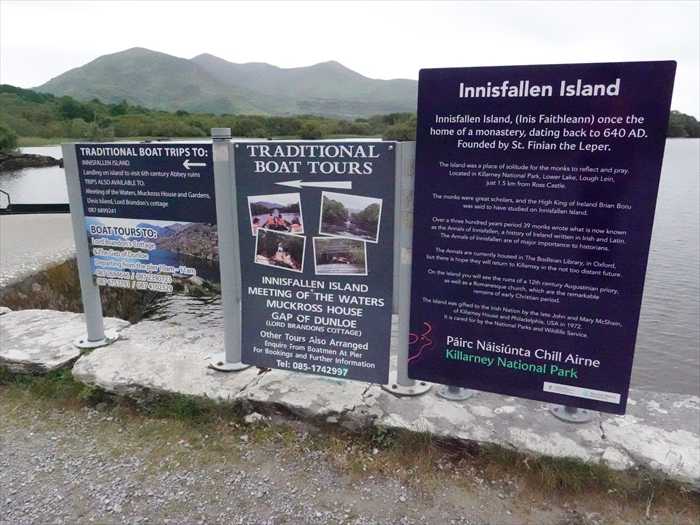
「 Innisfallen Island・イニスファレン島 」をネットから。

さらに「 Ross Castle・ロス城 」周囲を 南に向かって 歩く。

ロス城(Ross Castle)の敷地内にある 屋外ピクニックエリアの軽食・カフェ施設 。

西側の主塔(タワーハウス) を見上げて。

「 Ross Castle Garden Café(ロス城ガーデンカフェ) 」。

吊り下げられた花籠や白い窓枠が印象的。
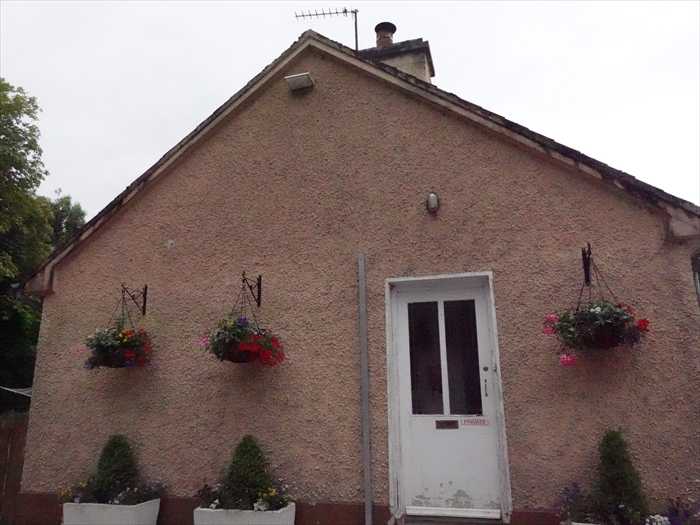
一周して東側に戻る。
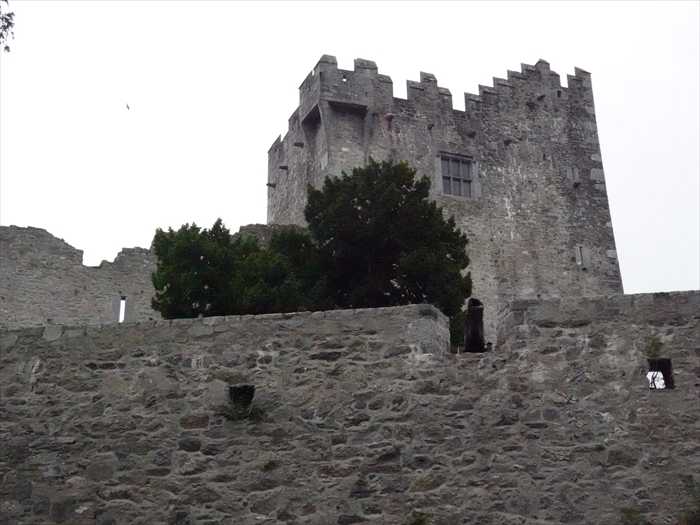
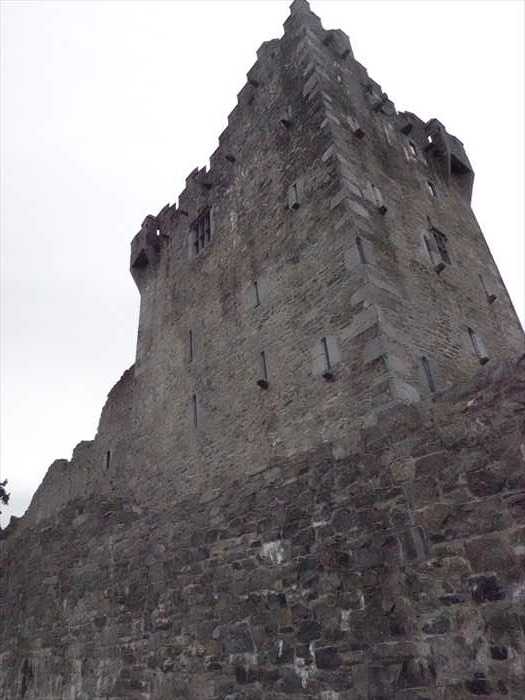
大砲。
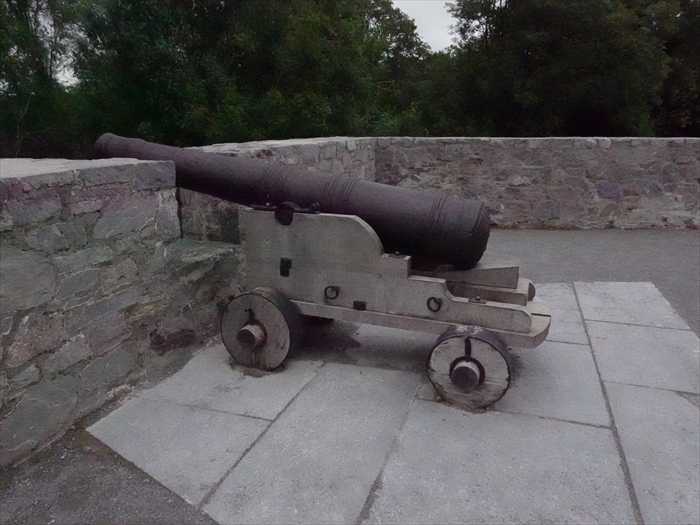
ロス城は15世紀後半にO'Donoghue Mór一族によって建てられた塔屋式城館(Tower House)。
1652年、クロムウェル軍に包囲され、湖から砲艦で攻撃され降伏。
このときの伝説では「湖から砲撃されるまでロス城は陥落しない」と信じられていた。
この大砲はその歴史的場面を再現する展示物と。

ロス城の周囲を1周して 観光客用入口まで戻る。
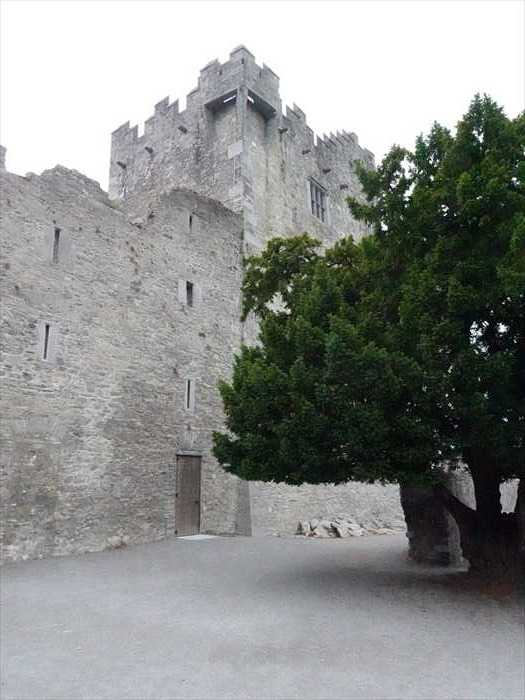
観光客用入口。時間は9:27。
開館時間は9:30~。
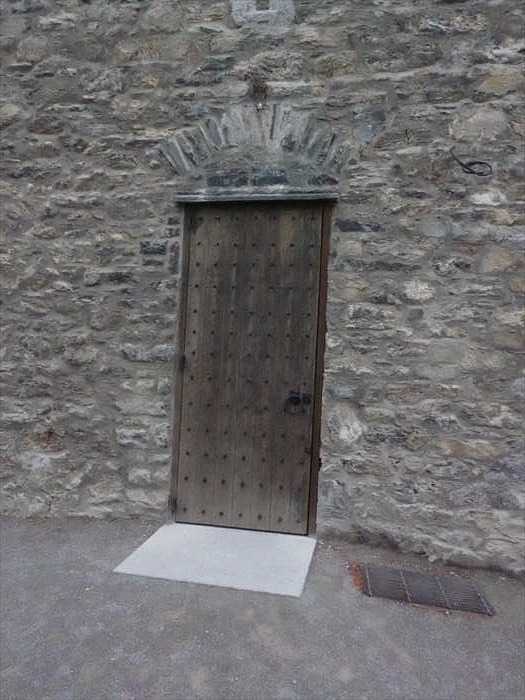
左側の角の部分には 小型の見張り塔 が設置され、監視・防御の拠点となっている と。
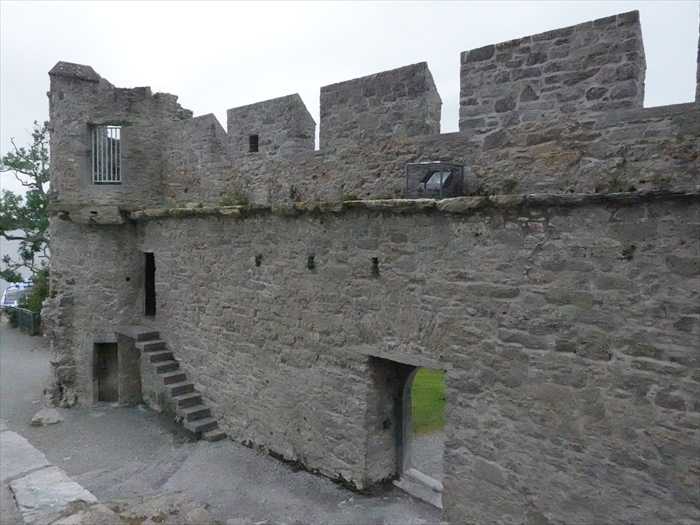
廻り込んで。
ここにも角塔 (タレット:turret) が。
城壁の角や出隅に取り付けられた小さな塔で、通常は円形か八角形。
この部分は 見張り台(watchtower)や防御用の射撃位置(defensive turret) として
使用された と
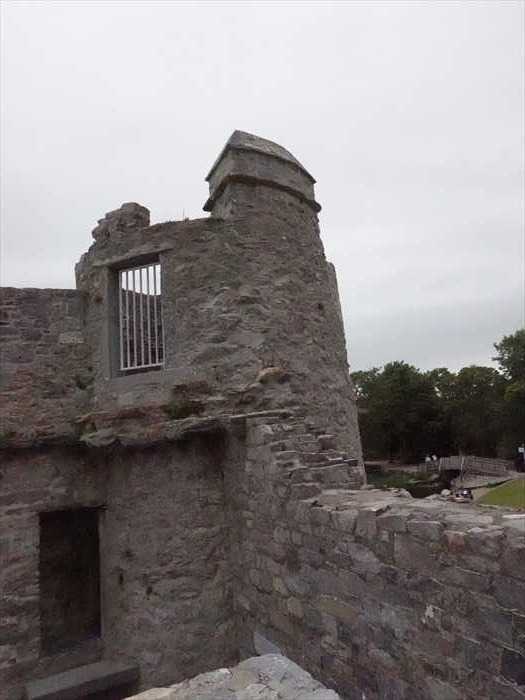
・・・ もどる ・・・
・・・ つづく ・・・
内部から外部へ射撃可能、外部からはほぼ攻撃不可能な構造である と。

マーダーホール(Murder Hole)
※上部
最上部の出っ張った部分には、石や熱湯、油などを下に落とす穴(マーダーホール)が
設けられていた可能性がある と。
設けられていた可能性がある と。
①主門や通路の上に設けられ、侵入者に対して上から攻撃できる防御機能。
②バトルメント(Battlements)とマシュクリレーション(Machicolation)
最上部のギザギザのような部分(城塞の縁)は、「バトルメント(胸壁)」と呼ばれ、
兵士が隠れながら反撃できる構造です。
兵士が隠れながら反撃できる構造です。
一部の部分が張り出し、その下に開口部がある構造は「マシュクリレーション」といい、
ここからも石や矢を落とせるようになっている。
ここからも石や矢を落とせるようになっている。
③窓(格子付き)や換気用スリット
中央部のやや幅の広い開口部は、後世に追加された格子付きの窓である可能性がある と。

レイン湖遊覧船(Lake Cruise Boat)。
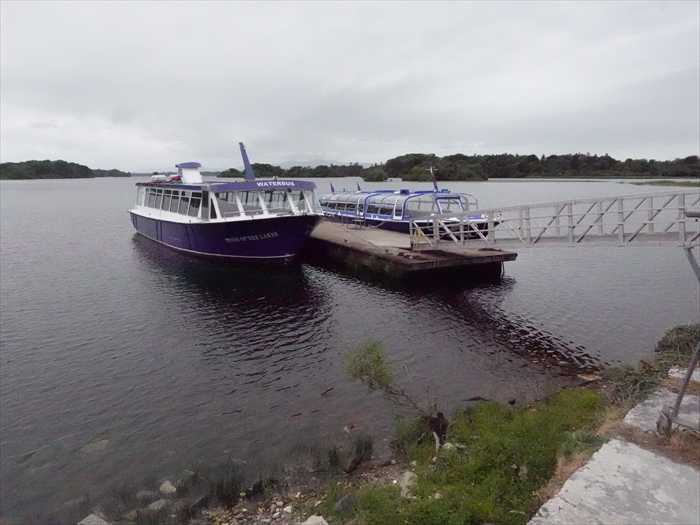
廻り込んで、 ロス城(Ross Castle)のタワーハウス(Tower House)・主塔を西側から 。

レイン湖遊覧船(Lake Cruise Boat)。

廻り込んで、 ロス城(Ross Castle)のタワーハウス(Tower House)・主塔を西側から 。
写真のこの面には窓が少なく狭いのがわかります。これは防御性を高める設計。
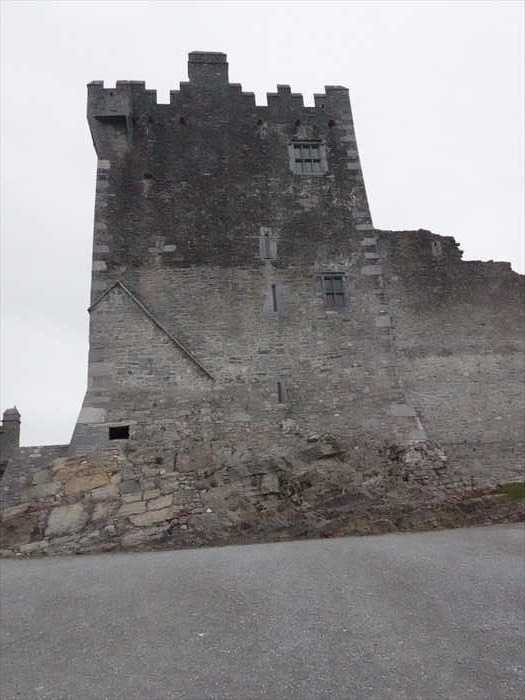
左側の建物(角楼・砲塔) は 城の主塔(タワーハウス)や城壁の隅を防御するための見張り
および砲撃用の施設 。特にこの塔は海や湖側からの侵入に備える構造。
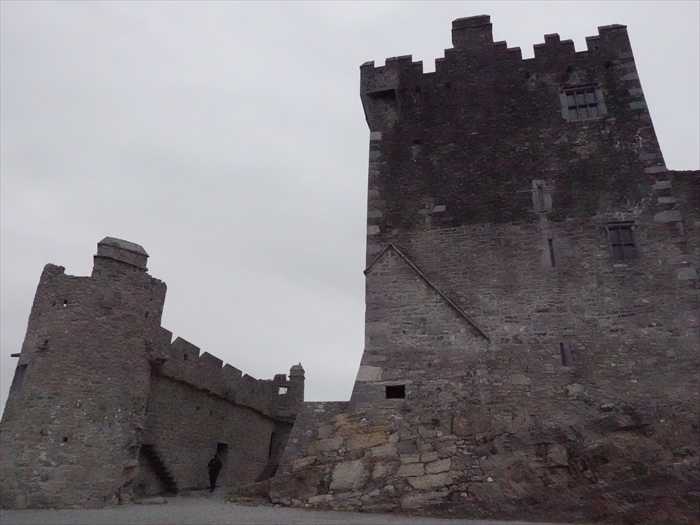
「 Killarney National Park(キラーニー国立公園)
Killarney National Park, 10,289 hectares in extent, comprises the mountains and
woodlands which surround the world famous Lakes of Killarney, as well as the three Lakes themselves. The Park includes the peaks of Mangerton, Torc, Shehy and the Purple
mountains. Just to the west of the Park rises MacGillycuddy's Reeks, the highest
mountain range in Ireland.
The nucleus of the National Park is the 4,000 hectare Bourn Vincent Memorial Park,
formerly known as the Muckross Estate, which was presented to the State in 1932
by Mr. and Mrs. W. Bowers Bourn and their son-in-law Senator Arthur Vincent to be
Ireland’s first National Park.
In 1981, the Park was designated as a Biosphere Reserve under the UNESCO Man and
the Biosphere Programme. It is therefore a part of a world network of natural areas
which have conservation, research, education and training as major objectives.
Killarney National Park is part of the largest candidate Special Area of Conservation
(SAC) in the country under the EU Habitats Directive as well as being an Special
Protection Area (SPA) under the EU Birds directive.」
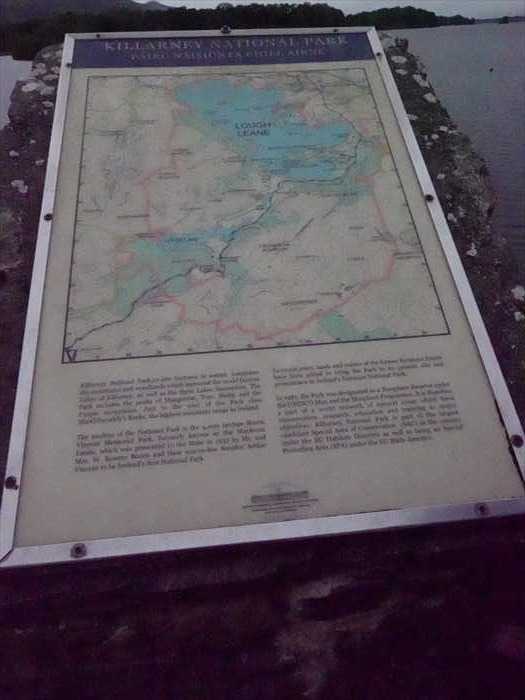
【キラーニー国立公園
キラーニー国立公園は、10,289ヘクタールにおよび、世界的に有名なキラーニー湖群とそれを
囲む山々や森林を含んでいます。公園には、マンガートン山、トーク山、シーヒー山、
パープルマウンテンズ(紫の山々)の山頂が含まれています。公園の西側には、アイルランド
最高峰の山岳地帯「マクギリカディ・リークス」がそびえ立ちます。

左側の建物(角楼・砲塔) は 城の主塔(タワーハウス)や城壁の隅を防御するための見張り
および砲撃用の施設 。特にこの塔は海や湖側からの侵入に備える構造。

「 Killarney National Park(キラーニー国立公園)
Killarney National Park, 10,289 hectares in extent, comprises the mountains and
woodlands which surround the world famous Lakes of Killarney, as well as the three Lakes themselves. The Park includes the peaks of Mangerton, Torc, Shehy and the Purple
mountains. Just to the west of the Park rises MacGillycuddy's Reeks, the highest
mountain range in Ireland.
The nucleus of the National Park is the 4,000 hectare Bourn Vincent Memorial Park,
formerly known as the Muckross Estate, which was presented to the State in 1932
by Mr. and Mrs. W. Bowers Bourn and their son-in-law Senator Arthur Vincent to be
Ireland’s first National Park.
In 1981, the Park was designated as a Biosphere Reserve under the UNESCO Man and
the Biosphere Programme. It is therefore a part of a world network of natural areas
which have conservation, research, education and training as major objectives.
Killarney National Park is part of the largest candidate Special Area of Conservation
(SAC) in the country under the EU Habitats Directive as well as being an Special
Protection Area (SPA) under the EU Birds directive.」

【キラーニー国立公園
キラーニー国立公園は、10,289ヘクタールにおよび、世界的に有名なキラーニー湖群とそれを
囲む山々や森林を含んでいます。公園には、マンガートン山、トーク山、シーヒー山、
パープルマウンテンズ(紫の山々)の山頂が含まれています。公園の西側には、アイルランド
最高峰の山岳地帯「マクギリカディ・リークス」がそびえ立ちます。
国立公園の中心は、かつてマックロス・エステートとして知られていた4,000ヘクタールの
ボーン・ヴィンセント記念公園であり、1932年にW.・バワーズ・ボーン夫妻およびその娘婿
アーサー・ヴィンセント上院議員から国家に寄贈され、アイルランド初の国立公園となりました。
ボーン・ヴィンセント記念公園であり、1932年にW.・バワーズ・ボーン夫妻およびその娘婿
アーサー・ヴィンセント上院議員から国家に寄贈され、アイルランド初の国立公園となりました。
近年では、旧ケンメア領地の土地と水域が加わり、今日の規模とアイルランドを代表する
国立公園としての地位を確立しました。
国立公園としての地位を確立しました。
1981年には、UNESCOの「人間と生物圏計画」の下で生物圏保護区に指定され、保全・研究・
教育・訓練を主要目的とする世界的な自然保護ネットワークの一部となっています。
キラーニー国立公園は、EUの「生息地指令」に基づく最大規模の特別保護区域(SAC)候補地で
あり、また「鳥類指令」に基づく特別保護地域(SPA)でもあります。 】
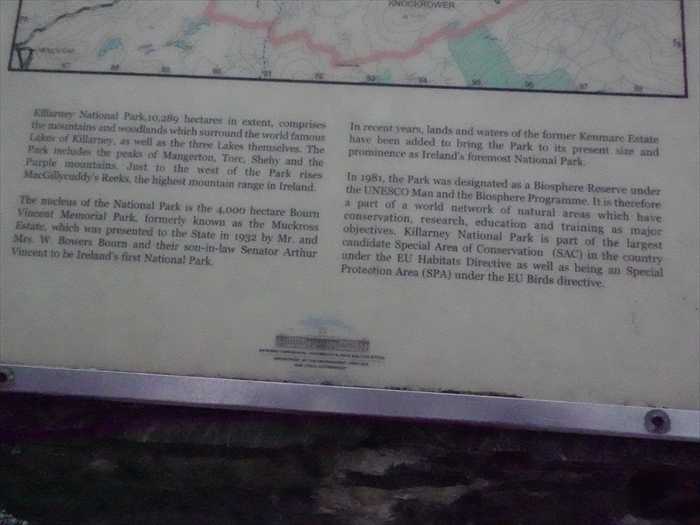
「 Innisfallen Island
Innisfallen Island (Inis Faithleann) once the home of a monastery, dating back to
640 AD.Founded by St. Finian the Leper.
The Island was a place of solitude for the monks to reflect and pray.
Located in Killarney National Park, Lower Lake, Lough Lein, just 1.5 km from Ross Castle.
The monks were great scholars, and the High King of Ireland Brian Boru was said to
have studied on Innisfallen Island.
Over a three hundred years period 39 monks wrote what is now known as the Annals of Innisfallen, a history of Ireland written in Irish and Latin. The Annals are considered of
major importance to historians.
The Annals are currently housed in the Bodleian Library, in Oxford, but there is hope
they will return to Killarney in the not too distant future.
【イニスファレン島
教育・訓練を主要目的とする世界的な自然保護ネットワークの一部となっています。
キラーニー国立公園は、EUの「生息地指令」に基づく最大規模の特別保護区域(SAC)候補地で
あり、また「鳥類指令」に基づく特別保護地域(SPA)でもあります。 】

「 Innisfallen Island
Innisfallen Island (Inis Faithleann) once the home of a monastery, dating back to
640 AD.Founded by St. Finian the Leper.
The Island was a place of solitude for the monks to reflect and pray.
Located in Killarney National Park, Lower Lake, Lough Lein, just 1.5 km from Ross Castle.
The monks were great scholars, and the High King of Ireland Brian Boru was said to
have studied on Innisfallen Island.
Over a three hundred years period 39 monks wrote what is now known as the Annals of Innisfallen, a history of Ireland written in Irish and Latin. The Annals are considered of
major importance to historians.
The Annals are currently housed in the Bodleian Library, in Oxford, but there is hope
they will return to Killarney in the not too distant future.
On the island you will see the ruins of a 12th century Augustinian priory, as well as a Romanesque church, which are the remarkable remains of this early Christian period.
The Island was gifted to the Irish Nation by the late John and Mary McShain,
of Killarney House and Philadelphia, USA in 1972.
of Killarney House and Philadelphia, USA in 1972.
It is cared for by the National Parks and Wildlife Service.
Páirc Náisiúnta Chill Airne
Killarney National Park」 【イニスファレン島
イニスファレン島(アイルランド語: Inis Faithleann)は、かつて修道院のあった島で、
西暦640年にまで遡る歴史を持ちます。
西暦640年にまで遡る歴史を持ちます。
創設者はハンセン病の聖フィニアン(St. Finian the Leper)です。
この島は、修道士たちにとって祈りと内省の静かな場でした。
この島は、修道士たちにとって祈りと内省の静かな場でした。
場所はキラーニー国立公園のレイン湖(Lough Leane)下湖部(Lower Lake)にあり、
ロス城(Ross Castle)から約1.5kmのところにあります。
修道士たちは高い学識を持ち、アイルランドの大王ブライアン・ボル(Brian Boru)もここで
修道士たちは高い学識を持ち、アイルランドの大王ブライアン・ボル(Brian Boru)もここで
学んだと伝えられています。
約300年の間に、39人の修道士がアイルランドの歴史を記した『イニスファレン年代記
(Annals of Innisfallen)』をアイルランド語とラテン語で著しました。これは歴史的に極めて
重要な史料とされています。
この『年代記』は現在、イギリス・オックスフォードのボドリアン図書館に所蔵されていますが、
将来的にはキラーニーへの返還も期待されています。
島には、12世紀のアウグスティノ会の修道院跡や、ロマネスク様式の教会の遺構があり、
初期キリスト教時代の貴重な名残を見ることができます。
この島は、1972年にジョン&メアリー・マクシェイン夫妻(米フィラデルフィア/キラーニー・
ハウス)よりアイルランド国家へ寄贈されました。
現在は国立公園・野生動物庁により管理されています。】
「 Innisfallen Island・イニスファレン島 」をネットから。

さらに「 Ross Castle・ロス城 」周囲を 南に向かって 歩く。

ロス城(Ross Castle)の敷地内にある 屋外ピクニックエリアの軽食・カフェ施設 。

西側の主塔(タワーハウス) を見上げて。

「 Ross Castle Garden Café(ロス城ガーデンカフェ) 」。

吊り下げられた花籠や白い窓枠が印象的。

一周して東側に戻る。


大砲。

ロス城は15世紀後半にO'Donoghue Mór一族によって建てられた塔屋式城館(Tower House)。
1652年、クロムウェル軍に包囲され、湖から砲艦で攻撃され降伏。
このときの伝説では「湖から砲撃されるまでロス城は陥落しない」と信じられていた。
この大砲はその歴史的場面を再現する展示物と。

ロス城の周囲を1周して 観光客用入口まで戻る。

観光客用入口。時間は9:27。
開館時間は9:30~。

左側の角の部分には 小型の見張り塔 が設置され、監視・防御の拠点となっている と。

廻り込んで。
ここにも角塔 (タレット:turret) が。
城壁の角や出隅に取り付けられた小さな塔で、通常は円形か八角形。
この部分は 見張り台(watchtower)や防御用の射撃位置(defensive turret) として
使用された と

・・・ もどる ・・・
・・・ つづく ・・・
お気に入りの記事を「いいね!」で応援しよう
【毎日開催】
15記事にいいね!で1ポイント
10秒滞在
いいね!
--
/
--
© Rakuten Group, Inc.










